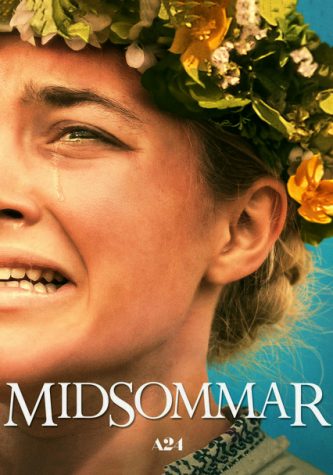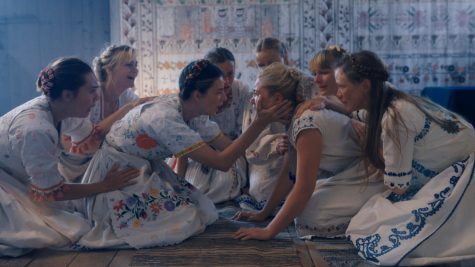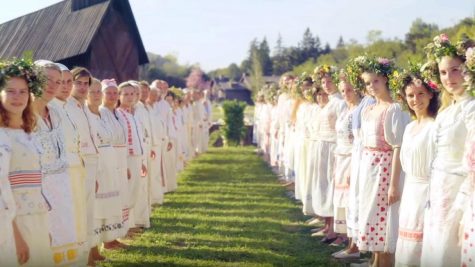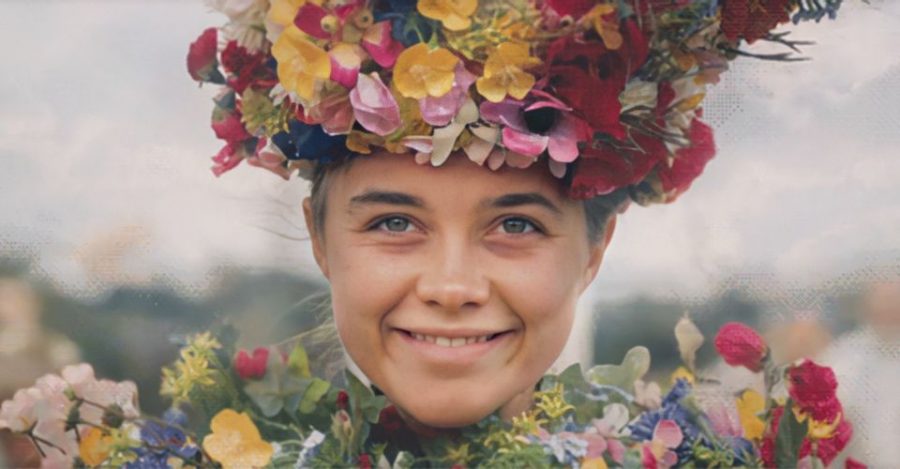Your Guide to “Midsommar”
May 11, 2021

As someone who does not particularly enjoy horror movies, usually for their bad reputation for cheap jumpscares, predictable plots, and that overall uncomfortable feeling you get while watching. I, however, had high hopes that were easily fulfilled for the 2019 smash hit “Midsommar”, a thriller/horror movie directed by Ari Aster, previously famed for his work in “Hereditary”(2018).
The movie follows Dani (Florence Pugh) and her boyfriend Christian’s (Jack Reynor) rocky relationship as they journey with Christians friends; Pelle (Vilhelm Blomgren), Mark (Will Poulter), and Josh (William Jackson Harper) to a fabled Swedish Midsommar festival in Pelle’s remote home village.
Dani, whose life is filled with continuous loss and loneliness, feels that she is scaring Christian away, so she tags along on the trip. She was right, as seen in the first few minutes of the film, Christians friends encourage him to leave Dani for the attractive “swedish milk maids”. Tensions are high when the group finally leaves, but it is soon overlooked as they enter the bright and cheerful Hårga village.

While trying to cope with the never ending flow of psychedelic drugs the community runs on, the group of “friends” try to assimilate into the community, but soon realize that the bright and innocent people and traditions of the Hårga are much more sinister than it had first seemed. What started out as an educational vacation will soon become a traumatic and disorienting struggle to find power and family in a life that has only known emotional abuse and loneliness.
This movie is full of hidden secrets and obvious hints you only find if you watch it twice, or, if you’re looking for it. The easiest thing to focus on are the jarring and obviously out of place murals and tapestries. The movie itself starts with about a minute or so simply focused on a single tapestry, which is literally the plot.

In a puzzling but effective choice, director Ari Aster, quite literally shows his audience the entire plot of the film before we even meet the main characters. As the film continues, we are given more hints and puzzle pieces to our characters’ fates through their reactions to certain places or artworks which, once the film is finished, fall into place in an extremely satisfying “aha moment”.
Although the tapestries are likely the most important aspects to stay aware of, you should also pay attention to the background scenes. There are times in which you’ll want to lose yourself in the tiny details, but if you do(and you definitely will), don’t lose sight of the larger picture. There may be a familiar face in the background or a recurring line that suggests more than you first realized. Ari Aster makes it obvious, almost painfully, when he wants you to take note of any foreshadowing necessary for the flow of the story, but the feeling of understanding more than what is expected is much more fulfilling.
An odd but powerful theme, untapped by most of the movie industry, is the subtle inclusion of the viewer in the lives of our characters. As our main character Dani experiences a new world, we are introduced to them as well through subtle effects on our point of view. Although I recommend keeping a broad mind while watching, there is a danger of focusing too much on noticing everything at once rather than surrendering yourself to Ari Aster’s carefully placed subconscious cues, permanently affecting your overall interpretation of “Midsommar”’s aesthetic.

The themes of this film directly interact with its aesthetic. The bright clothes and beautiful long summer days in which terrors take place play with the offputting idea of fearing the day, rather than the night. I had watched “Midsommar” late in the evening, as one does with horror films, and while walking up the stairs to my room(arguably the scariest part of the horror film experience) I realized I had no reason to be unnerved. I had no reason to suspect a monster to be around the corner or disfigured hands to grab my ankles from under my bed.
All of the tragedies in “Midsommar” have nothing to do with the common thriller theme of darkness, and the situations themselves had no grounding in the average consumer’s everyday life. This is proof of Ari Aster’s success in plot development. Aster was able to develop a film whose horror is entirely unrelatable to us viewers. We think it more likely to be jumpscared by slenderman than to be subdued by a psychotic cult. Yet we still feel unsafe when the film ends.
The ending of “Midsommar” kept me scouring for answers that just merely led to conspiracies, nothing solid or certified, so, after you’ve seen this film, let me know what you think about these specific oddities placed casually in the film that have no real answers yet. Why do we smile at the end? Is this a happy ending? What happens to Dani? Why does the group member lie to the others?



Sarah Sloyer • Nov 8, 2024 at 9:58 am
I loved this movie so much and I’m so glad to see someone break it apart in the way that it deserves. I loved how you acknowledged that there was no real reason for the viewer to be scared after watching the movie. There wasn’t really any jump scares or anything that’s applicable to an everyday person, but I didn’t really think about that when I watched it. I think this article went in depth, but I would almost love to see it go further.